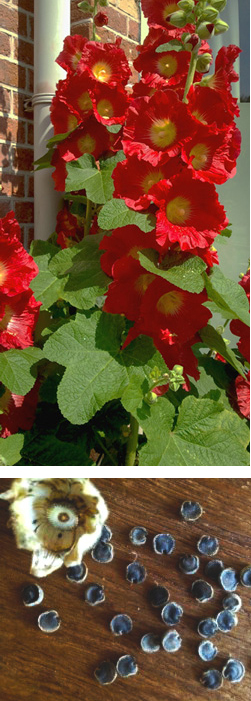Hollyhock, the Virtues of a City Herb

Hollyhock (Alcea rosea) is one of my preferred urban herbs. Beyond its impressively tall upright stems, it is city tolerant, medicinal, and edible. Growing as a perennial, biennial or annual, depending upon the location, it is easily raised from seed in most soil types, preferring full sun and thriving in anything from a sandy concrete crack to a fertile flowerbed. In Amsterdam, they fill many tree pits and pavement gardens. Although many locals appreciate their beauty, few are aware of its properties.
Soothing Uses
Hollyhock honey can soothe and reduce the severity of coughs, colds, and bronchitis. It can be made simply by filling a glass jar with fresh hollyhock flowers and then pouring in runny honey. Leave to infuse for a few weeks. And to calm the stomach, a cup of hollyhock tea can be an effective home remedy. Steep one flower in a mug of boiled water for five minutes.
Hollyhock flowers between July and late August in a brilliant array of colours. Deep purple varieties yield a dye for textiles and drinks. The flowers and young leaves dry and store well. They can be eaten cooked or raw. Try adding finely chopped young leaves to casseroles, or flowers to summer salads.
Saving seeds
Now is the time to save the seeds of this urban stalwart. When fully formed and ripe (August to October), the dry wheel-shaped seed heads can be harvested and stored in paper bags, but leave plenty behind for city wildlife to eat. Sow the seed thinly in treepits, deep plant pots, wasteland, or against supports in spring. Hollyhock is a perfect guerrilla gardening plant. It has a lust for city life and offers so much to the people and wildlife sharing urban space.
Further reading
A Modern Herbal. Vol I. Mrs M. Grieve.
Edible and Medicinal Flowers. Margaret Roberts.
Photo credits: Lynn Shore

